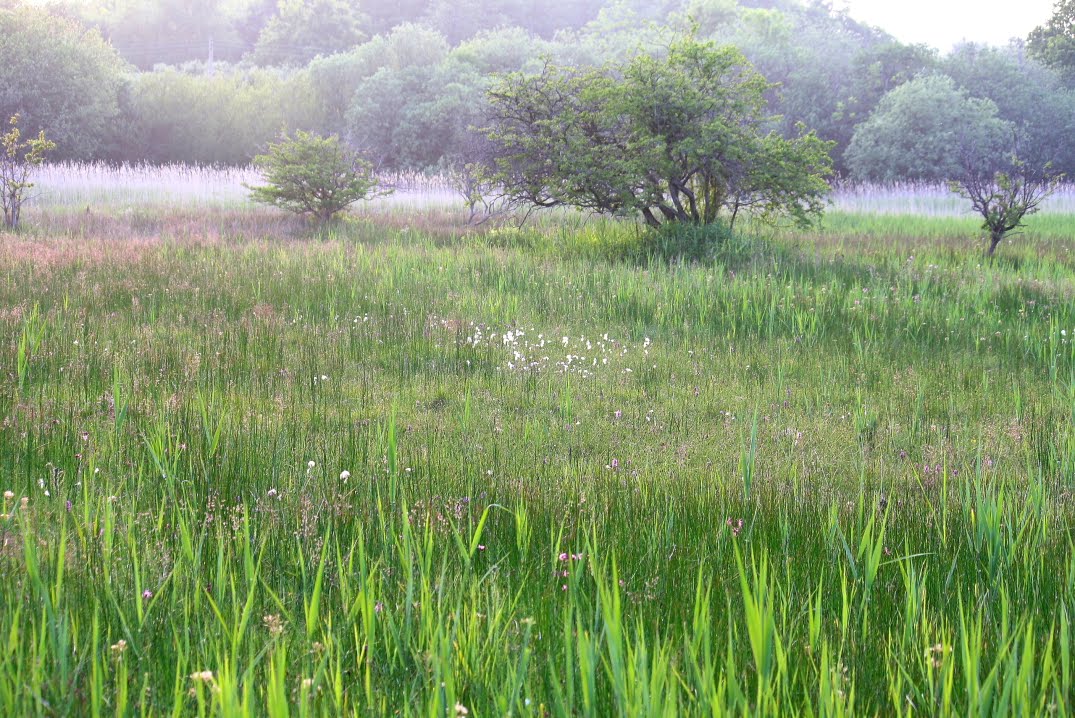The cutting season proper having finished at the end of last
month, this was the last scheduled work party of the winter. We had been
thwarted by the weather in completing all of our tasks on the main common, but
no such impediments affected this session, on Pit Common. With a week of almost
wall-to-wall sunshine, Spring appears to have happened in a rush. Flowers are
blooming, bees and butterflies are making early tentative flights, and the
frogs on both our ponds have been busy spawning. Here’s some spawn in the
secluded Scouts’ Pond.
And the birds are starting to sing. On that subject, I recently read about some clever research looking at the creeping degradation of that glory of the season; the dawn chorus. Rachel Carson warned the world of the catastrophe coming if the use of pesticides was allowed to continue unchecked, calling her hugely influential book Silent Spring. Well, fortunately it’s not silent, yet, and we can still marvel at the racket made by some birds at least. A walk the other day revealed my first chiffchaffs of the year, along with robins, blackbirds, song thrush, dunnocks, noisy great tits and many spirit-soaring larks ascending. The research, using data from the British Trust for Ornithology’s long-running Breeding Bird Survey and other citizen science datasets from across Europe and North America, explored how the soundtrack of spring has changed. Going back over 25 years, records of breeding birds in various locations were combined with recordings of those species, from the excellent Xeno Canto online database. (This is well worth exploring, at www.xeno-canto.org. A huge number of recordings of hundreds of species are there for free, so if you want to know what a particular bird sounds like, this is the site to visit.)
The sad fact is that the soundscape is greatly reduced from
only 25 years ago; there are drastically fewer individual birds, and the number
of species occurring at many places has also fallen dramatically. So whilst the
dawn chorus here might still be loud, it is no longer as richly varied as it
was only very recently. The value of this research is that it takes a step back
in time, allowing for an accurate comparison with today. A phenomenon known as
‘Shifting Baseline Syndrome’ means that younger people who have never
experienced past abundance can only compare today’s position to their own
earliest memories, and thus the true extent of decline is hidden. Techniques
such as this can help decision makers understand the extent of the loss, and with
luck do something to reverse it – which is where we volunteers come in.
The Magnificent Dozen convened at Pit Common on another
beautiful sunny morning; ironic perhaps, since we had arguably more pressing
work to do a month ago when the weather was so awful we couldn’t get it done.
The work for this session was to cut the vegetation between the pond and the
road; give the grass a light mow, prior to most of it being left to grow for
the season, with some paths mown through it; and to create a dumping area away
from general view for future use.
Here's how the chosen area looked before our attention
The assembled company consisted of hewers of wood…
… wielders of loppers…
… the man who came to mow…
… the man who came to cut brush…
… and the highly skilled builder of dead hedges…
As is traditional, half way through the session came the
half-time break, including particularly welcome chocolate biscuits. A highly
attentive crew gathered round Team Leader Julie while she filled us in on NWT’s
management plan for the site. We’re anxiously awaiting the results of the
ensuing test!
Fed, watered and briefed, we all went back to work with a will, and were pretty pleased with ourselves at the end of the session.
Here’s the finished dead hedge – impressive eh?
The area cleared of a prickly mass of mainly dead brambles is
now ready for what we can dump there in the future, to rot down quietly out of
sight.
The mown area
The roadside verge
The Pit itself is looking good
As mentioned above, both our ponds have had some very busy frogs, and hopefully toads. There are large clumps of spawn in the Pit, albeit not easily photographed in the bright sunlight.
As well as the frogspawn, the bottom of this picture also shows the wretched invasive Crassula which is infesting both ponds.
And on the
subject of invasive pernicious weeds, our next session is likely to be to remove
Himalayan Balsam once it shows itself. And so the world turns, as it must…
Here is Team Leader Julie’s message of thanks:
Hello
all
We
hope that you are all enjoying the lovely blue skies and sunshine we are being
treated to. We held our final work party
of the season today at the Pit. Twelve volunteers made short work of the first
grass cutting of the season along with clearing a large area towards the back
of the site - which will be used as our future dump site (out of sight from the
road).
On
behalf of all the team leaders (and NWT) we would like to thank all those who
have given their time over the season on the SSSI Common, School Common and at
the Pit. It is amazing how much our group of dedicated volunteers achieve across
the three areas. NWT are very grateful and always impressed with what we
achieve.
For
those of you who are happy to do it there will be some smaller work parties
from around May tackling the very invasive Himalayan Balsam. I will put out an
email when these are scheduled.
Otherwise we look forward to seeing you all in the late summer when we
are allowed to cut the reed on the main SSSI Common again.
Enjoy
your spring and summer.
Regards,
Julie (for the TLs)















